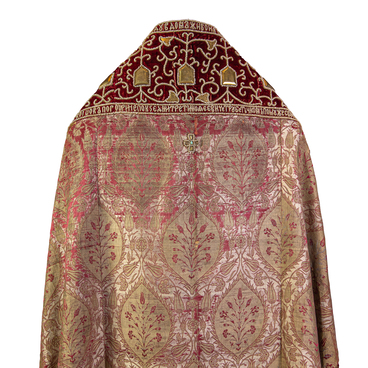This phelonion — a liturgical vestment — was donated to the Trinity Lavra of St. Sergius by Princess Anna Trubetskaya in 1627 to commemorate during church services her diseased husband Prince Dmitry Trubetskoy. He was a well-known political and military figure of the Time of Troubles, took part in the liberation of Moscow from the Poles in 1612. Before Mikhail Romanov ascended to the throne, the prince had been the ruler of the state. The new tsar appointed him military governor of Tobolsk, where he unexpectedly died in 1625.
Dmitry Trubetskoy was buried, as well as his closest relatives — his father, brother and first wife — in the monastery of St. Sergius. Anna Trubetskaya, the prince’s second wife, provided many items for funeral and memorial rituals to the monastery, which were to be used during memorial services at her husband’s tomb: an icon, a burial shroud, an altar cross, a censer, a dish, two ripidia — liturgical fans in the form of a six-winged seraphim, silver vessels, liturgical priest and deacon vestments, including this phelonion.
The shoulderpiece (the part of the garment covering the shoulders) made of dark red velvet is studded with pearls and decorated with gilded decorative plaques with carved plant-based ornaments and engraved images of saints, including the patrons of the Princess and her husband. On the edges along the neckline and the lower edge of the shoulderpiece, the inscription is made with pearls: “In the summer of 7133/1625/ on June 21, the vestments were given as a contribution to the house of the Life-Giving Trinity of our Reverend Fathers Sergius and Nikon of Radonezh Miracle-Workers in memory of Prince Dmitry Timofeevich Trubetskoy by his wife, princess.”
The phelonion was sewn of moiré — Turkish golden watered silk of the late 16th — early 17th centuries. “Watered silk” was a dense silk fabric with gold and silver patterns. The pattern of this fabric consisted of leaf-shaped cubes — in Russia it was called “kupchaty”. Flowers and rose, tulip, carnation, rosehip and iris buds were woven with golden threads, white, crimson and blue silk.
The hem of the phelonion is made of luxurious Spanish velvet of the late 15th — early 16th century, that is, a fabric that at the time of the creation of the phelonion was already more than 100 years old. A complex pattern of intertwining, spiraling stems with carved leaves and flowers is made with silk pile and loops of spun gold threads.
Dmitry Trubetskoy was buried, as well as his closest relatives — his father, brother and first wife — in the monastery of St. Sergius. Anna Trubetskaya, the prince’s second wife, provided many items for funeral and memorial rituals to the monastery, which were to be used during memorial services at her husband’s tomb: an icon, a burial shroud, an altar cross, a censer, a dish, two ripidia — liturgical fans in the form of a six-winged seraphim, silver vessels, liturgical priest and deacon vestments, including this phelonion.
The shoulderpiece (the part of the garment covering the shoulders) made of dark red velvet is studded with pearls and decorated with gilded decorative plaques with carved plant-based ornaments and engraved images of saints, including the patrons of the Princess and her husband. On the edges along the neckline and the lower edge of the shoulderpiece, the inscription is made with pearls: “In the summer of 7133/1625/ on June 21, the vestments were given as a contribution to the house of the Life-Giving Trinity of our Reverend Fathers Sergius and Nikon of Radonezh Miracle-Workers in memory of Prince Dmitry Timofeevich Trubetskoy by his wife, princess.”
The phelonion was sewn of moiré — Turkish golden watered silk of the late 16th — early 17th centuries. “Watered silk” was a dense silk fabric with gold and silver patterns. The pattern of this fabric consisted of leaf-shaped cubes — in Russia it was called “kupchaty”. Flowers and rose, tulip, carnation, rosehip and iris buds were woven with golden threads, white, crimson and blue silk.
The hem of the phelonion is made of luxurious Spanish velvet of the late 15th — early 16th century, that is, a fabric that at the time of the creation of the phelonion was already more than 100 years old. A complex pattern of intertwining, spiraling stems with carved leaves and flowers is made with silk pile and loops of spun gold threads.



